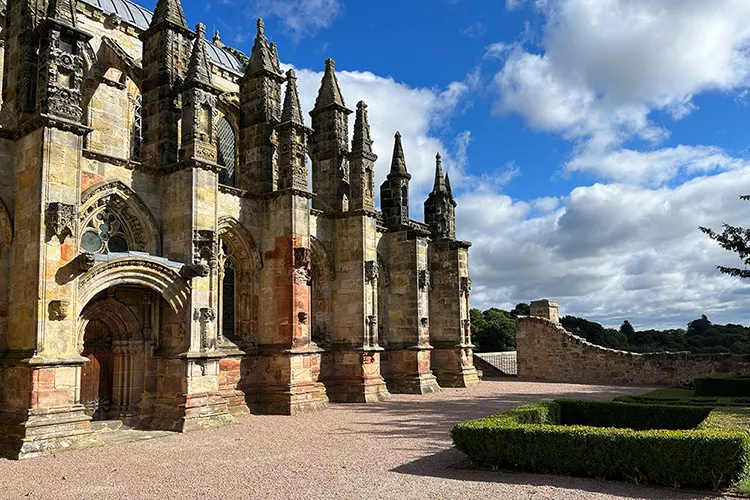
A Battery Energy Storage System in Pillswood, Hull. Image credit Fully Charged Show.
Battery Energy Storage Systems have been in the news this week as Recommendation not to object to Battery Energy Storage System in the Borders.
In Midlothian there is already an application for a BESS on Land to North of Former Quarry Broad Law Gorebridge and recently the Buccleuch Group has hosted a public information day as they are due to submit an application for a BESS on land on Salters Road.
So what is a BESS? We thought it would be a good idea to put together this explainer article.
A Battery Energy Storage System (BESS) is like a big rechargeable battery that stores electricity. It works by storing excess electricity when it’s available, such as when the sun is shining or the wind is blowing, and then releasing it when needed, such as during peak demand times or when there’s a power outage. BESS helps balance the supply and demand of electricity, making the National grid more stable and reliable.
A BESS is important for several reasons:
Overall, Battery Energy Storage Systems play a critical role in modernizing and enhancing the resilience, reliability, and sustainability of the electrical grid. They enable the efficient storage and utilization of electricity, supporting the transition to a cleaner and more sustainable energy future.
A BESS stores electrical energy in the form of chemical energy within batteries for later use. It typically consists of one or more battery packs, power conversion systems, and control systems.
Here’s a breakdown of its components and functionality:
We hope you found this explanation useful. The video below from the Fully Charged Show is also worth a watch.

Inception Art Show has announced the dates for its return to Dalkeith Palace from Friday 3rd May to Sunday 12th May 12th 2024. The art sales exhibition will feature an exciting programme alongside an impressive collection of sculptors, artists, photographers, and painters exhibiting within the historic cultural venue, Dalkeith Palace.
The 2024 edition of Inception Art Show will showcase a carefully curated collection of over 30 artists, with 10 talented new artists joining for the first time. Building on the success of previous years, the exhibition will open its doors to the public on Friday 3rd May at 10am, running for 10 consecutive days, including a new Family Day.
“I am delighted to see Inception return to Dakeith Palace again this year” says Charlotte Rostek who directs the development of the Palace. “It has really become our flagship show signalling a whole new chapter in the story of this remarkable building and one we are excited to see unfold over the coming years.”
With a focus on contemporary art and sales, Inception Art Show promises an enriching experience for art enthusiasts. This year, 35 modern and contemporary artists will ‘take over’ the Palace, offering visitors the opportunity to engage with the artists and their creations over the course of 10 days.
“Working alongside the artists, we hope to create an immersive cultural experience that showcases the art at its best and engages directly with visitors” said Walter Dalkeith who along with Taisir Gibreel and Charlotte Rostek curate the show each year. “We are proud to create this platform for visitors to purchase artwork and support the incredible creativity and talent on show”.
In addition to the exhibition, Inception Art Show will feature an exciting programme of events, including Family Day, Palace tours, and an online charity auction in support of our charity partner, My Name’5 Doddie Foundation. This addition to the Inception programme, gives visitors the opportunity to bid for works by many of the Inception artists, painters & photographers, all for a worthy cause, in partnership with the charity auction company Impulse Decisions.
“The support we receive from the public makes an important difference to our ability to invest in vital MND research and we are thrilled that Dalkeith Country Park is supporting us through their Inception Art Show. Finding effective treatments for MND is a team effort and we’re sure that this fantastic partnership will be a popular one!” said Paul Thompson Director of Fundraising and Communications, My Name’5 Doddie Foundation.
Moreover, families are invited to enjoy a special new Inception Family Day sponsored by Savills, which will include family-friendly workshops and demonstrations on 11th May 2024.
Entrance tickets to the Inception Art Show cost £3 and are now on sale. The exhibition is open daily from Friday 3rd May to Sunday 12th May, from 10.00 to 16.00. We also run daily, pre-bookable guided tours of the Palace.

Visitors to Rosslyn Chapel, in Midlothian, are still strongly influenced by its role in The Da Vinci Code according to new research undertaken to mark the 21st anniversary of the book, which was first published on 18th March 2003.
Research carried out by Shanks Research Consultancy with 6,677 Chapel visitors between March 2023 and March 2024, reveals that –
– 49% of visitors said that Dan Brown’s novel, and the subsequent film, was a factor influencing their decision to visit the historic site.
– 72% of them had read the book and seen the film.
– 43% of them said that The Da Vinci Code was either a ‘very important or important’ influence.
Ian Gardner, Director of Rosslyn Chapel Trust, said ‘It is remarkable that The Da Vinci Code continues to have such a strong influence on our visitors, 21 years since it first appeared. It has had a huge impact on the profile of Rosslyn Chapel and has significantly increased levels of visitor numbers, which rose from 38,141 to 79,916 after the book was published and to more than 176,000 when the film was released. This has helped us complete a comprehensive conservation project at the Chapel and undertake a major programme of restoration and repair at Rosslyn Castle, enabling future generations to appreciate these unique buildings.’
In 2023, the Chapel welcomed 142,211 visitors, as numbers started to increase following the pandemic.
In the story of The Da Vinci Code, the main characters, Robert Langdon and Sophie Neveu, investigate a murder in the Louvre and, in doing so, follow a set of clues to unravel a mystery to find the Holy Grail, taking them to London and then to Rosslyn Chapel. Since publication, the novel has been translated into 44 languages and has sold more than an estimated 80 million copies, making it one of the best-selling novels of all time.
Neil Christison, VisitScotland’s Regional Director, said: ‘Rosslyn Chapel is one of Scotland’s iconic attractions and a hugely important driver of tourism in Midlothian. The Da Vinci Code was a global phenomenon and it’s wonderful that the book and film are still influencing visitors to this day. This new research chimes with our own visitor surveys which continue to show that film and television productions are still referenced by visitors, sometimes decades, after their initial release.’
He continued: ‘Scotland’s historic sites have been the backdrop to many productions, and this is a great example of the positive impact of screen tourism, which can help support the conservation of our amazing built heritage.’
Rosslyn Chapel was founded in 1446 by Sir William St Clair. The beauty of its setting, in rural Midlothian, and the mysterious symbolism of its ornately carved stonework have inspired, attracted an intrigued visitors and artists ever since. The Chapel is open to visitors throughout the year.
Dan Brown has previously said: ‘When I decided to write The Da Vinci Code, I knew that its finale would have to take place at the most mysterious and magical Chapel on earth – Rosslyn’.